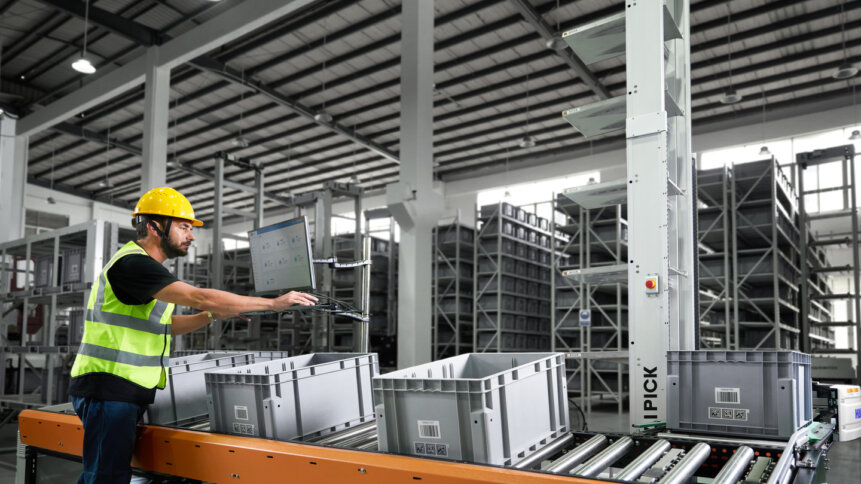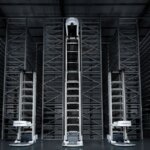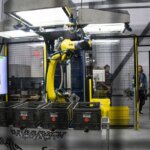Robots-as-a-service – the future of warehouses?

We recently sat down with Damien Skinner, UK Country Manager at Hai Robotics, for a look at what the warehouse of the future would look like. While we were talking, Damien mentioned that future warehouses would probably be built very differently to legacy warehouses, and potentially filled with robotic workers supplied in a whole new way – robots-as-a-service.
THQ:
How will the warehouses of the future be designed?
READ NEXT

The warehouse of the future
DS:
That will be split between two main user-groups – smaller, regional, and start-up warehouse owners, and larger companies with much higher throughput, even up to multi-national level like Amazon.
The big and the small
For the smaller companies, the key will be scalability – the ability to start small and grow to take advantage of the space and robotics capabilities they need as the business grows, so you may have more urban, relatively vertical warehouses, with a handful of robots and a very visual proposition to start with, for easy learning. Then you’ll be able to add in robots to deal with increased demand as and when you need them.
For larger companies, the key concern will be flexibility. They’ll need a solution that can adapt, change, grow – or even shrink – according to the customer demand. Imagine you have data on your regular monthly throughput, and you have only the robots you need to deal with that, because of course your bottom line is key.
Then you hit the preparation for Black Friday, Christmas, and the January sales. Boom – you’re going to need a lot more robots to deal with the peak demand in those three months. So you’ll need a solution with flexibility to help you cope with that – and that’s where robots-as-a-service (RaaS) comes in.
Using that model, where you lease the robots you need to deal with peak throughput, but aren’t tied into a purchase model, will allow large warehouse owners to reduce their capital expenditure, and deal with those productivity-spikes as an operating expense.
THQ:
That feels instinctively like it demands a lot of disruption to the system – adding new robots, and then removing them when you don’t need them anymore.
RaaS – a new way to do robotics
DS:
Ah, but it needn’t be that much hassle. I mean, the way you’d do it with traditional automation is that when you have a peak of need, you’d try to bring the peak down so your existing system could handle it, and then pay your operatives additional money to stay on longer and get the reduced peak dealt with.
And yes, your traditional automation system would tend to be hardwired, heavy plant, miles of complicated belts and all that, so yes, traditionally, that’d be the way you’d think of an expansion – lots of work, lots of upheaval, and probably not something you could economically do just for, say, three months of the year. Traditional automation definitely ran you into that complexity, cost, and capital expenditure mire.
The future will be easier
But with a RaaS system, if the supplier has the robots in stock, they’re relatively easy to put in place. And you update your warehouse management system to recognize a new robot on the line, and as soon as it recognizes the task it’s there for, boom! You’ve increased your throughput – and by using operating expense, rather than capital expenditure.
It’s not as easy yet as it will be as the system matures and gets more well known and used, but it’s about as easy as moving house, compared to having to knock down your existing house and building a new one in your new location. The RaaS model is the key to “as-needed” robofication of warehouses in the future. It can be done right now, but in the future, it will be done easily, regularly, and ahead of time, to maximize throughput in those months of peak demand.
Drags on development
THQ:
What stands in the way of that development right now?
DS:
There’s a degree to which the technology is there, but the will for it needs to grow. As I say, we had a big supermarket come to us recently and say “We want a completely automated warehouse,” and the technology to deliver that is here today. But people will be squeamish just yet about the idea of complete automation.
THQ:
The science fiction factor.
DS:
Yes. And there’s also a sense that revolutionary technologies simply take time to achieve a kind of critical mass. It’s like car manufacturing – go into a car factory these days and it’s mostly all robots doing the construction. Logistics and warehouse technology is often around 2-3 decades behind the car manufacturing industry – so we’re getting there, in terms of time.
It also takes significant leadership to deliver this kind of paradigm shift. Ours is coming from the likes of Amazon.
If you look at what Amazon’s warehouse designs were like five or ten years ago compared to now, they look completely different. It’s using Kiva robots now, because it invested in them 5-6 years ago, and it has completely change the landscape for warehouse design and automation.
Where before it was pick engines, pick towers, conveyors and people. Nowadays, it’s mostly robots with a few people.
The Luddite factor
THQ:
That’s probably a factor that makes the general public reticent about the all-robotic warehouse, isn’t it? The notion that enhanced use of robots means careers for human beings disappear. Will the warehouse of the future be entirely automated?
DS:
I always say there will still need to be humans in the warehouse environment – but they may not be the same humans as before. The monotonous jobs, like picking, may well be replaced by robots, and again, you can look to Amazon for that, but there’s going to be a need for more people in different roles. It could be an auditor of an order that’s already been created by robots, for example.
And there’s also going to be the need for maintenance engineers and software engineers.
THQ:
So there’ll still be humans in the warehouse of the future – they just won’t be the same people as were in the warehouse of the past?
DS:
Yes.
THQ:
How will the warehouse of the future tackle sustainability?
DS:
There are a handful of things that more robotic warehouses will be able to deliver in terms of sustainability. We would be looking at local robot manufacture to reduce shipping time and use of container ships or air freight. We could create spare parts on-site through 3D printing, rather than having large amounts of spares stored.
This takes a quantum leap, but you could also potentially have battery reconditioning programs and even solar charging stations to power up the robots – that’s not something you can necessarily do with human workers, so it brings sustainability benefits on top of the productivity, the flexibility, the scalability and the efficiency of the robot-forward warehouse of the future.









